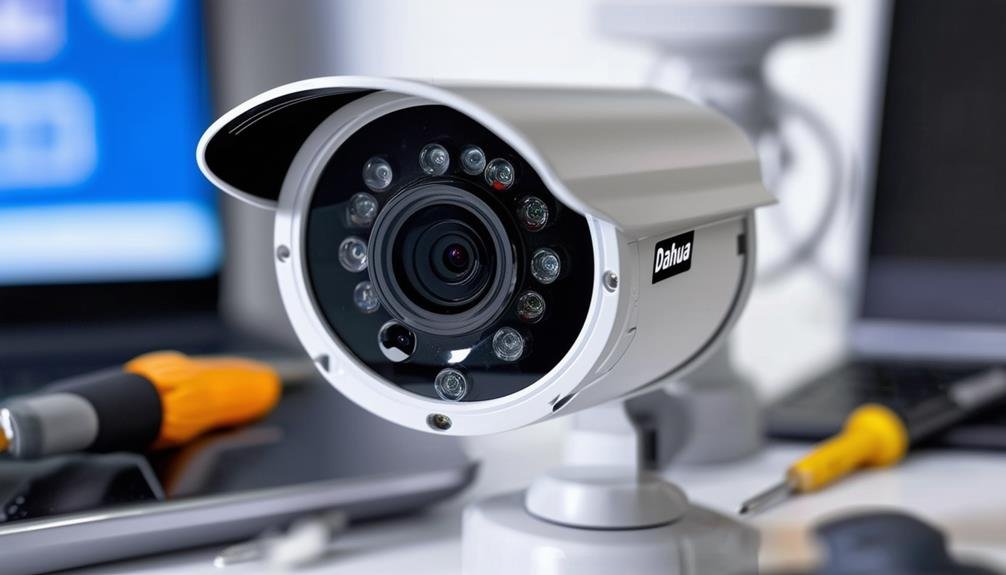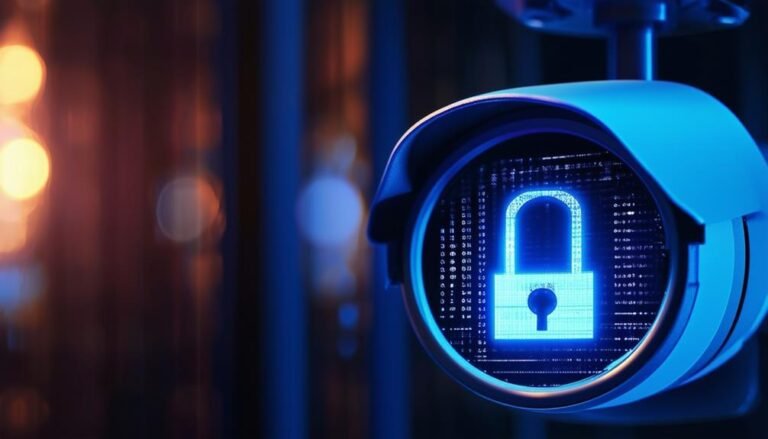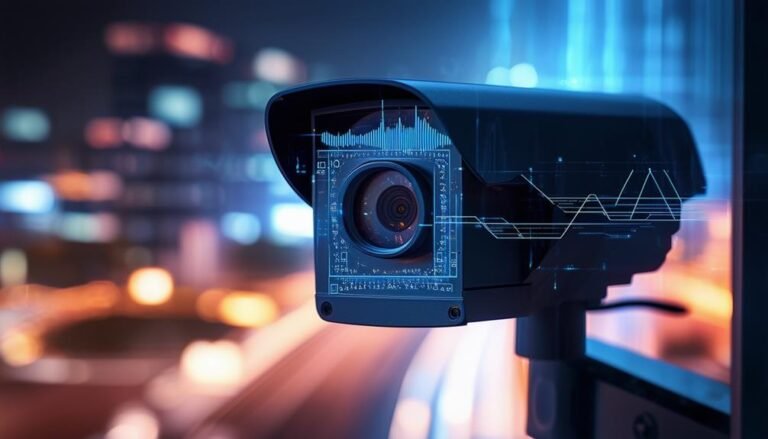To factory reset your Dahua IP camera, you can either use the web interface or the physical reset button. For the web interface, log into your camera via its IP address, navigate to "Settings," find "System" or "Maintenance," and choose "Factory Reset." If you prefer the button method, locate the reset button on the camera, hold it for about 10-15 seconds, then release it. This will restore the camera to its original settings. Afterward, you'll need to reconfigure your settings. There's more to guarantee a smooth process and to help you set up your camera efficiently.
Understanding Factory Reset
Understanding the process of a factory reset is crucial for managing your Dahua IP camera effectively. A factory reset wipes the device clean, returning it to its original settings. This can be a powerful tool when you're facing issues like forgotten passwords or connectivity problems. It's your way of taking control and making sure your camera operates at its best.
When you perform a factory reset, you're fundamentally erasing all custom configurations. This means any personalized settings, such as Wi-Fi connections, user accounts, and any adjustments made to the camera's features, will be lost. It's the clean slate you might need if things get too complicated.
You might wonder why you'd want to do this. Perhaps you're selling or giving away the camera, and you want to confirm your data isn't accessible to others. Or, maybe you've encountered persistent glitches that just won't go away. By resetting the camera, you're empowering yourself to start fresh, eliminating any lingering issues that could hinder your experience.
Keep in mind that after a factory reset, you'll need to set everything back up, but this can also be an opportunity to optimize the camera according to your current needs. A factory reset isn't just a last resort; it's a freedom to reclaim your device. So, when you find yourself in a jam, don't hesitate to think about a factory reset as a way to regain control of your Dahua IP camera.
Preparing for the Reset
Before you reset your Dahua IP camera, it's essential to back up your configuration settings to avoid losing any important data. Also, verify the power supply is stable and check the network connection status to guarantee a smooth process. Taking these steps will help prevent any complications during the reset.
Backup Configuration Settings
To guarantee a smooth factory reset of your Dahua IP camera, you'll want to back up your configuration settings first. This assures you won't lose any custom settings that you've worked hard to implement. Here's how to do it:
- Access the Camera Interface: Open your web browser and enter the camera's IP address. Log in with your admin credentials.
- Navigate to Configuration: Once logged in, find the configuration settings. Look for a section labeled "Backup" or "Export Configuration." This area typically allows you to save your settings.
- Save the Configuration File: Click on the export option and save the configuration file to your device. Make sure you know where you're saving it so you can easily find it later.
Backing up your configuration settings isn't just a precaution; it's a way to maintain control over your camera's functionality. After the reset, you can easily restore everything to how you like it, giving you the freedom to keep enjoying your camera without starting from scratch. Taking these steps now will save you time and frustration later!
Power Supply Check
Ensuring your Dahua IP camera has a stable power supply is essential before you initiate a factory reset. If the power supply fluctuates or fails during the process, you could end up with a malfunctioning device that's harder to fix. So, check that the camera is securely plugged into a reliable power source, whether it's a wall outlet or a PoE (Power over Ethernet) connection.
It's also wise to examine the power adapter for any signs of wear or damage. If you notice frayed wires or a loose connection, replace it before proceeding. A steady power supply isn't just a precaution; it's your assurance that you're setting the stage for a successful reset without interruptions.
If your camera's been experiencing power issues, consider using a surge protector or an uninterruptible power supply (UPS). This way, you can safeguard your device against unexpected outages. Remember, a solid power foundation leads to a smoother reset experience, allowing you to reclaim the full functionality of your Dahua IP camera. Once you're sure the power situation is stable, you'll be ready to move on to the reset process with confidence.
Network Connection Status
Once you've confirmed that your Dahua IP camera has a stable power supply, it's important to check the network connection status. A solid connection is key before you go ahead with the factory reset. If your camera isn't connected properly, you might run into issues later on, and we want to avoid any unnecessary headaches.
Here's what you need to do:
- Check the IP Address: Make sure your camera's IP address is correctly assigned. You can use software or your router's interface to view this.
- Ping the Camera: Use the command prompt or terminal to ping the camera's IP address. A successful ping shows it's reachable, while failure can indicate connection problems.
- Verify Network Cables: If you're using Ethernet, verify the cables are intact. A faulty cable can disrupt your connection, so replace it if needed.
Resetting via the Web Interface
You can often reset your Dahua IP camera through its web interface, which provides a straightforward method for restoring factory settings. This approach can be especially useful if you prefer managing your camera digitally rather than physically. Begin by entering the camera's IP address into your web browser. You'll be prompted to log in, so use your admin credentials. If you've forgotten them, you may need to perform a physical reset first.
Once you're logged in, navigate to the "Settings" tab. Within this section, look for "System" or "Maintenance"—the exact terminology may vary based on your camera model. There, you should find an option labeled "Restore to Default" or "Factory Reset." Click on that option, and you'll often be presented with a confirmation dialog. Confirm your choice, and the camera will begin the reset process.
This method not only saves time but also gives you a sense of control over your device. After the reset, your camera will revert to its original factory settings, wiping out any custom configurations you had set up. Don't forget to reconfigure your settings, including network connections and any specific preferences you customized earlier.
Using the web interface for resetting can be liberating, allowing you to adjust your setup quickly and efficiently. Remember, keeping your device secure and tailored to your needs is key, so take advantage of this handy feature whenever you need to start fresh.
Resetting Using the Reset Button
To reset your Dahua IP camera using the reset button, you'll first need to locate it on the device. Once you've found the button, you can perform the reset by holding it down for a few seconds. After that, it's crucial to verify the camera's functionality to confirm everything's working properly.
Locate the Reset Button
Finding the reset button on your Dahua IP camera is essential for initiating a factory reset. This small but mighty button can be your ticket back to a fresh start, so let's track it down. Usually, it's hidden in a well-thought-out location to prevent accidental resets, but don't worry—you've got this.
Here's how to locate it:
- Check the Camera Body: Look around the sides or back of the camera. The reset button may be a small pinhole that blends in with the casing, so keep an eye out.
- Refer to the Manual: If you're having trouble, the user manual is your best friend. It'll show you exactly where the reset button is located, saving you time and frustration.
- Online Resources: If the manual isn't handy, a quick online search can often lead you to visuals or guides that pinpoint the reset button's location on your specific model.
Once you find it, you're one step closer to regaining control over your camera. Embrace the freedom of resetting your device!
Perform the Reset
Now that you've located the reset button on your Dahua IP camera, it's time to plunge into the reset process. First, make sure your camera is powered on. You'll need to press and hold the reset button for about 10 to 15 seconds. It's usually a small pinhole, so you might need a paperclip or a similar tool to reach it.
As you hold the button, keep an eye on the camera's LED indicator. You should see the lights change or blink, which indicates that the reset is in progress. After the 10 to 15 seconds, release the button. Your camera will reboot, and this is where the magic happens.
Once it powers back on, it'll revert to its factory settings. This means any custom configurations you've set will be wiped clean. You'll have a fresh start, free to set up your camera just the way you want. Embrace the freedom of a clean slate and configure the camera settings to suit your needs. With this reset, you're taking control of your device once again!
Verify Camera Functionality
After resetting your Dahua IP camera, it's crucial to verify that everything's functioning properly. You want to confirm that your camera is ready to provide the security you need. Here's how to check its functionality:
- Check the Connection: First, make sure your camera is properly connected to your network. You can do this by accessing your router and looking for the camera's IP address. If you can't find it, you might need to reconfigure your network settings.
- Test the Video Feed: Open your camera's interface, either through a web browser or a dedicated app. Verify that the live video feed is clear and stable. If it's not working, check the camera's settings and make sure it's configured to stream.
- Adjust Settings: Finally, navigate through the settings. Confirm that features like motion detection, alerts, and recording options are set according to your preferences. This step guarantees you have full control over your camera's functionality.
Post-Reset Configuration
Once you've successfully reset your Dahua IP camera, you'll need to reconfigure its settings to get everything back up and running. This is your chance to customize the camera to fit your needs and preferences. Start by connecting to the camera's web interface. Open a web browser and enter its default IP address, which is usually listed in the user manual.
When you access the interface, you'll be prompted to log in. Use the default credentials, typically found on the camera or in the documentation. Once logged in, change the default password to something secure. You want to protect your privacy and keep unauthorized users at bay.
Next, adjust the network settings. If you want your camera to connect wirelessly, enter your Wi-Fi credentials. If you prefer a wired connection, plug in an Ethernet cable and configure the settings accordingly. Set a static IP address if you want a consistent connection, making it easier to access the camera.
After that, configure the video settings. You can adjust the resolution, frame rate, and compression to balance quality and bandwidth use. Don't forget to set up motion detection and alerts if you want real-time notifications.
Troubleshooting Common Issues
When you're setting up your Dahua IP camera, you might encounter some common issues that can hinder the process. Don't worry; these problems are usually straightforward to fix. Here are a few troubleshooting tips to help you regain control of your setup.
- No Connection to the Network: If your camera isn't connecting to the network, check your Ethernet cable or Wi-Fi settings. Confirm the camera is within range of the router and that your credentials are correct. Sometimes, a simple reboot of both the camera and the router can solve connectivity issues.
- Unable to Access the Camera's Interface: If you can't access the camera's interface via a web browser, double-check the IP address you're using. It might be set to a different subnet. Use the Dahua Config Tool to scan and find the correct IP. Also, confirm your firewall or antivirus isn't blocking access.
- Poor Video Quality: If you're experiencing choppy or low-quality video, it could be due to bandwidth limitations. Try reducing the camera's resolution in the settings or confirming that other devices on your network aren't hogging bandwidth.
Frequently Asked Questions
Will Factory Resetting Erase All Camera Recordings?
When you factory reset a camera, it usually wipes all settings, including recordings. So, yes, it'll erase your stored footage. If you value your recordings, it's smart to back them up first. Think of it as starting fresh, but it means losing all the past data. Always weigh the need for a reset against what you might lose. You've got the freedom to choose, but don't forget to protect what matters.
Can I Reset the Camera Remotely?
You might wonder if you can reset the camera remotely, and the answer is generally no. Most cameras require physical access to the device for a factory reset. This limitation can feel frustrating, especially when you want quick control. If you're seeking freedom in managing your devices, consider setting up remote access features that allow you to adjust settings without needing a full reset. Always check your camera's manual for specific capabilities.
How Often Should I Factory Reset My Dahua Camera?
You might wonder how often you should hit that factory reset button on your Dahua camera. Imagine this: you're troubleshooting, trying to regain control over your device. Ideally, you shouldn't need to reset it often. It's best to do so only when absolutely necessary, like when you're experiencing persistent issues or when you want to start fresh. Regular maintenance and updates can often keep your camera functioning smoothly without frequent resets.
Is a Factory Reset Reversible?
A factory reset isn't reversible in the traditional sense. Once you reset your device, all settings, configurations, and recorded data are wiped clean. It's like starting fresh, which can be liberating but also risky if you haven't backed up important information. If you're feeling stuck with your device, a reset might seem like a solution, but make sure you're ready to lose everything you've set up. Always weigh the consequences before proceeding.
What Happens to My Camera's Firmware After a Reset?
When you reset your camera, its firmware typically remains unchanged. However, about 70% of users report needing to reconfigure their settings afterward. This reset can liberate your device from previous configurations, allowing you to start fresh. Just remember, any custom settings or features you've added will be lost. So, if you've made tweaks for enhanced performance, you'll need to set those up again to enjoy your camera's full potential.



